Sindhi clothing
Sindhi clothing (Sindhi: سنڌي پھراو), Both Sindhi women and men wear the shalwar qameez or the kurta with pyjama. Women also wear sari or ghagra. However, before the adoption of the Shalwar kameez and the kurta, the sari as well as other articles of clothing, Sindhis had their own traditional costumes.
| Part of a series on |
| Sindhis |
|---|
 |
 Sindh portal |
Background
Original dress code of Sindhi women was Lehnga Choli with long veil, up until the 1840s, women started wearing the suthan underneath the lehnga, later on around 1930s with time Sindhi women stopped wearing lehnga and only wore sindhi suthan and choli got replaced by long cholo, and men originally wore Dhoti or Lungi and a long or short angrakho or jamo later angrakho was replaced by sindhi kurta called Pehriyan and dhoti/lungi was replaced by Sindhi salwar/suthan/kancha.[1]
In the past, Older Sindhi women wore paro (petticoat), thick poplin cholo (blouse/Tunic), and chaadar (a sheet of veil). Some wore sleeveless hip length Shirt with a waist-length koti (blouse) with sleeves, on top, and a malai satin, Sussi or Bandhani paro or suthan (culottes or palazzo). The younger women wore velvet or amber pyjama (suthan) both at home and outside. Also they wore a long skirt (jablo) on top and a thick poplin blouse and a Rawa/Gandi/Pothi (long muslin, tie and dye or ajrak printed headscarf). Middle aged and young ladies wore churidar pyjama (sorhi suthan). Over time, older ladies started to wear the Salwar Kurta with Slippers (Sapato, Jutti, Khusso or Mojri).[2][3] When women of good family leave the house, they hide the Suthan under a wide Paro (or Peshgir, petticoat), which conceals the person from the waist to the ankles. Over the upper part of the body they throw a Rawo (or Salur, large white veil). Among females of the Sayyid race, especially in the northern parts of Sindh, wear the Burko/Chadree of Arabia and Persia is much used. Hindoo women wear the Paro larger and longer than the Muslimah; they usually prefer the Cholo without a Gaj, and throw a white veil over the head.[4][5] Sindhi women are fond of wearing a multitude of ornaments. These are also distinguished by some minutiae make in the ornaments and jewels of muslim and hindu, but these are unobservable. The most important ornament for a married muslim sindhi women is the Nath, or bullo/bulli/phuli (Nose jewel) which shows their marital status. In Sindh, the bangles worn peculiar are the large rings of ivory covering the fore arm;[6] these are worn by all sects, religions and classes. But nowadays glass bangles and gold or silver "kangar/Karo" "bracelets" are more commonly used.[4]
The original dress of the Sindhi male was a Dhoti worn by hindu men and "Lungi" (sarong) by muslim men, jamo/angrakho (top) and achhi pagirhi (White Turban) and a block printed shawl called ajrak or other shawls locally made.[3] Men also carry different colored floral/checkered piece of cloth on shoulder or as turban, also used as handkerchief.[2] Rich men wore sherwanis (long coats) with gold buttons. Some poor men also wore a "Puthiyo or Kiriyo" a cotton jacket resembling a Mirzai of India, with a sash around waist called bhochhan. During a cold season men wore a long coat in the shape of "kaba" wadded with cotton or a "Nimtano" (a coat of the same description, with arms down to the elbows). The rich are fond of handsome furs; the poor content themselves with afghan posteen a Masho, or Chogho (cloak made of felt goat's and camel's hair). The slippers were of two kinds 1st "Jutti", made of red or yellow leather, in shape not unlike those worn by the Egyptians, and 2nd, "Ghetalo" of the same material embroidered with cloth or silk. Wealthy men when travelling, wear a kind of leather top boot called "Mozo", in the hills a sole made of the leaves of a kind of dwarf palm called "Teesh" was used to protect the feet.[7] The traditional clothes of Sindh can still be seen on men and women today.
Traditional clothing
During the medieval period and prior to the Mughal rule, the costumes worn by the people of Sindh resembled the dresses worn in Iraq and adjoining countries.[8][9] The dresses included short tunics and Iraqi style long robes. If any drawers were used, they were of the Iraqi style, such as the pantaloons which were also adopted in neighbouring Multan and also in the coastal areas of Gujarat.[10] However, the use of such Iraqi clothes in Sindh was limited to Mansura,[11] the Arab capital city, established in 712 C.E.[12] and was not universally adopted throughout the region. Arab rule in Sindh ended in 1050 C.E.[13] Further, alongside these dresses, Sindhis also wore other traditional attire.
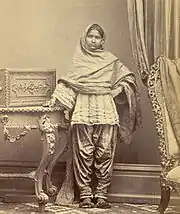 | |
| Type | Dress |
|---|---|
| Introduced | Historic |
Traditional Sindhi kancha (shalwar)

The traditional Sindhi drawers are the shalwar[14] style adopted from Iraq[15] and neighbouring countries. The Sindhi shalwar, also called kancha,[16] can be described as wide pantaloons[10] which do not begin to gather at the knees as does the modern Sindhi suthan, and are wide at the ankles.[16] The Sindhi shalwar is plaited at the waist.[17] Both garments are loose down to the ankles, where they are gathered. Both garments have the same origins in the pantaloons of Iraq,[18][19] which are still worn by the Kurds.[20][21]
The Sindhi shalwar however, was not universally adopted in the region, where it was limited to Mansura. In time too, Arab rule which introduced the Iraqi dress, ended in the 11th century. Accordingly, the traditional Sindhi shalwar qamees.
It is not until the migration of people from Balochistan beginning during the 15th century C.E.[22] and picking up pace during the 18th century C.E.[23] that the use of the shalwar in Sindh was introduced on a wide level. However, the Sindhi shalwar, as the earlier version worn in Mansura, is not as wide and loose as the Balochi shalwar, which is very wide and loose.[24]
A suthan is traditionally tight fitting below the knees or around the ankles whereas any style of shalwar is loosely gathered at the ankles and does not tighten towards the lower parts of the legs.
Although it was not customary for women to wear the suthan during the early 19th century, men were seen wearing the traditional pantaloon style Sindhi shalwar/suthan during this period.[25] However, the suthan was not universally adopted by members of all religions to begin with,[26] but in 1872 it was noted that the use had spread to a wider audience.[27]
Female Dresses
Sindhi women traditionally wore sindhi lehenga choli and today sindhi women most commonly wear the Sindhi salwar cholo and a long veil with sindhi embroidery called bhart. Bhart varies from tribe to tribe and region to region, Traditional dress lehenga choli called Paro/Jablo/Peshgir/Ghaghro/Ghaghri choli/cholo/polko/gaj/kanjeeri is also worn today in some parts of sindh, some muslim women wear cholo instead of choli a long and loose blouse reaching below knees or sometimes to ankles, sindhi traditional women clothes are most vibrant and colorful with sindhi embroideries and mirror work, the various local floral prints, the Bandhani fabric (tie and dye technique, which is believed to be orignated from Sindh), the block printed fabric and the Sussi fabric is also very famous of Sindh. A full embroidered shirt is called Gaj. Some jut women in lower delta region of sindh wear a long robe like dresses similar to ancient arab women dress and some baloch women in sindh wear a frock like dress with a pocket infront called ghagho. The traditional clothes are worn with traditional silver and gold jewellery as well, The white full arm bangles are famous from mohen jo Daro, originally made out of ivory but today made from plastic.

 Sindhi women wearing traditional clothing on Sindhi Cultural Day in Jamshoro, Pakistan.
Sindhi women wearing traditional clothing on Sindhi Cultural Day in Jamshoro, Pakistan. Sindhi women wearing traditional clothing on Sindhi Cultural Day in Jamshoro, Pakistan.
Sindhi women wearing traditional clothing on Sindhi Cultural Day in Jamshoro, Pakistan. Sindhi women wearing traditional clothing on Sindhi Cultural Day in Jamshoro, Pakistan.
Sindhi women wearing traditional clothing on Sindhi Cultural Day in Jamshoro, Pakistan. Sindhi women wearing traditional clothing on Sindhi Cultural Day in Jamshoro, Pakistan.
Sindhi women wearing traditional clothing on Sindhi Cultural Day in Jamshoro, Pakistan. Sindhi women wearing traditional clothing on Sindhi Cultural Day in Jamshoro, Pakistan.
Sindhi women wearing traditional clothing on Sindhi Cultural Day in Jamshoro, Pakistan.
Lengha choli
Before the advent of the suthan and Sindhi cholo, the traditional dress was lengha (jablo) choli which is still worn by women in various parts of Sindh. Women in the Thakparkar district wear a ghagra, a heavier version of the lehnga, with either a loose or fitted choli,[28] or a kancera, a fully embroidered, backless blouse, held on by small cap sleeves and strings.[29]
Another upper garment is the gaji (pullover shirt) which is worn in the mountain areas of Sindh. The gaji is composed of small, square panels, embroidered on silk and sequins. The neck line of the gaji is cut high, and round on one side, with a slit opening extending the other. Unmarried girls wear the opening to the back and married women, to the front.[29]
The original outfit does not require a woman to wear a suthan underneath the lengha, and up until the 1840s, the skirt was commonly worn on its own.[30] Accordingly, the suthan for women is a relatively late adoption.[31] In parts of Sindh, the skirt is worn without the suthan.[32]
Modern Suthan (chareno)
By the 1930s,[1] the suthan, similar to the shalwar became the traditional lower garment worn by women in Sindh.[33] The Sindhi suthan, also called chareno, is similar to the Punjabi suthan of the Punjab region,[34] is heavily pleated, voluminous on the thighs, slightly narrowed on the knees, gathered in at the instep[16] and pleated to the ankles.[35][36][37]
Cholo
The Sindhi suthan was traditionally accompanied by the Sindhi cholo (boddice) and paro (petticoat/ghagra)[38][39] but now is worn with a cholo (kameez) only which is loose fitting,[40] and is made in a variety of ways, including the traditional method of the cholo opening at the front to the waist,[41][42] with very wide sleeves.[43] The traditional cholo can reach down to the ankles.[44]
Women generally wear a dupatta or odani (Veil) with the Sindhi suthan and Sindhi cholo suit to cover their head and shoulders. In the past, women wore a thin muslin scarf (rawa) bigger than the present day dupattas.[2]
Sindhi Julaba
Very loose ankle length garment in hand loom or hand-blocked material with a hood attached, with tie string at "V" opening in the neck and side slits at lower part extending to lower hem. Worn with or without hood in the villages of Sindh and can also be embroidered.[45][46]
Sindhi Suthan and Sindhi angelo
.jpg.webp)
The other outfit worn by males is the modern Sindhi suthan with the traditional peheren (Sindhi shirt) which is also called angerkho,[1] a short form of the kurta and fastened to the side.[47] An alternative name for the top is angeli which is short and left or right crossed, covering the chest, the shoulders and the arms. The sleeves are long and pleated. Large and wide pleats cover the belly.[35] The other upper garment is the traditional garment similar to a long gown.[48]
Sindhi headwears
Sindh has its own variety of hats/caps and turbans.
- Sindhi Topi: The Sindhi topi is a cylindrical skullcap with an arch shaped cut-out on the frontal side. The hat is embroidered with intricate geometrical designs with small pieces of mirrors or gemstones sewed into it.and it’s adopted from neighboring baloch when they start settling in sindh.
.jpg.webp)
- Talpur Hat/Serai Hat: The Talpur hat also called serai topi were unusual hats were usually made in brightly coloured velvets or flamboyant brocades, always with the contrasting panels at centre back and front of the drum. They were worn throughout the 19th century by muslims in Sindh. Originally monopolised by government officials and lawyers.
- Mogho Topu: The square hat, made of black cloth or kincob (cloth of gold), called "mogho topu", belonged to higher and wealthier classes. It is not worn anymore.[7]
There are three different kinds of turbans:[7]
- The Paga: A long cotton cloth, generally white, sometimes dyed.
- The Patako/Pothio: Resembling the former, but smaller and sometimes used ajrak or lungi cloth.
- The Phentiyo: A fold of cotton stuff, loosely twisted round the head. Bright in colors, usually of bandhani fabric.[7]
The lower orders prefer clothes dyed with indigo to white dresses[7] as latter show dirt too much, some people especially Fakirs, Dervishs and malangs wear green, black, red and orange color turbans. The black color is associated with Shah Abdul Latif Bhittai, Red color with Lal Shahbaz Qalandar, orange with Sachal Sarmast, and green with Shah Noorani, these all are sufi saints of Sindh.
.jpg.webp)
Ajrak
The block printed shawl known as Ajrak is used by men, women wear Maleer an ajrak version for women.
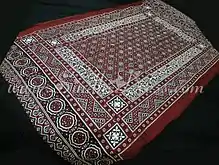
Modern clothing
Shalwar kameez
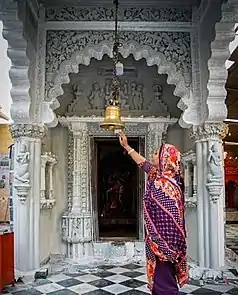
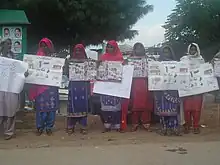
Men and women wear the straight cut Punjabi[49] shalwar kameez using local prints, embroideries and designs.
Sindhi kurta
The Sindhi kurta is the traditional straight cut variety worn in neighbouring Punjab[50][51] which is becoming increasingly popular in Sindh[52] but uses local patterns to embroidery the garment and also makes use of mirrors. The local art of bandhani (creating patterned textiles by resisting parts of a fabric by tying knots on it before it is dyed) is utilised which is believed to have originated in Sindh and spread to Gujarat via Rajasthan[53] and is also practiced in the Punjab region. Sindhi kurtas are also made out of heavy local material called rilli and the kurtas are often called rilli kurtas.[54] Ajrak prints are also used.
Western clothes are also worn by young boys and girls.
 Sindhi hat with Ajrak designs. Scarf with bandhani prints
Sindhi hat with Ajrak designs. Scarf with bandhani prints Ajrak
Ajrak Ralli/rilli material of Sindh
Ralli/rilli material of Sindh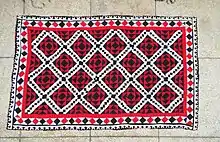 Ralli/rilli
Ralli/rilli
References
- I Am a Sindhi: The Glorious Sindhi Heritage / The Culture and Folklore of Sind By J. P. Vaswani
- http://blogs.rediff.com/raindrop/2007/07/08/sindhi-2-dress/#comments%5B%5D
- "Sindhi Clothing – Sindhi Khazana". Retrieved 2023-05-25.
- Burton, Richard (1992). Sindh and the Races that Inhabit the Valley of the Indus: With Notices of the Topography and History of [the] Province. Asian Educational Services. ISBN 978-81-206-0758-3.
- Gazetteer of the Province of Sind ... government at the "Mercantile" steam Press. 1907.
- Magedin, Shireen (2022-05-07). Lifelines. AUSXIP Publishing.
In many Sindhi tribes married women had to wear ivory-colored bangles that covered their arms? Your great grandmother used to wear them. She told me that an ideal set would have included seventeen bangles worn on the upper arm and nine on the lower arm; a total of fifty-two bangles on each arm." My great grandmother? I listened with interest.
- Burton, Sir Richard Francis (1851). Sindh, and the Races that Inhabit the Valley of the Indus. W. H. Allen.
 This article incorporates text from this source, which is in the public domain.
This article incorporates text from this source, which is in the public domain. - Verma, Harish Chandra (1986) Dynamics Of Urban Life In Pre-Mughal India
- amiyat-ul-Falah (1967)The Voice of Islam, Volume 16
- Kumar, Raj (2008) Encyclopaedia of Untouchables Ancient, Medieval and Modern
- Chandra, Moti (1973) Costumes, Textiles, Cosmetics & Coiffure in Ancient and Medieval India
- Hamdard Islamicus, Volumes 3-4 (1980)
- Claus, Peter J. Diamond, Sarah. and Mills Sarah (2003) South Asian Folklore: An Encyclopedia : Afghanistan, Bangladesh, India, Nepal, Pakistan, Sri Lanka
- Mumtaz Husain Pathan (1974) Arab kingdom of al-Mansurah in Sind
- Sir Henry Miers Ellio (1850) Bibliographical Index to the Historians of Muhammedan India, Volume 1
- Burton, Richard (1996) Sindh and the Races that Inhabit the Valley of the Indus: With Notices of the Topography and History of [the] Province
- Reginald Edward Enthoven, Stephen Meredyth Edwardes (1909) Provincial series: Bombay presidency ...
- Satish Saberwal, Mushirul Hasan (2006) Assertive Religious Identities: India and Europe
- Said, Hakim Mohammad (1990) Road to Pakistan. 1. 712 - 1858
- Harris, George Lawrence (1958) Iraq
- Laurie, Thomas (1855) Dr. [A.] Grant and the mountain Nestorians
- Bolton, Heather . Shafqat, Saeed (2007) New perspectives on Pakistan: visions for the future
- Gayer, Laurent (2014) Karachi: Ordered Disorder and the Struggle for the City
- Postans, Thomas (1843) Personal Observations on Sindh: The Manners and Customs of Its Inhabitants; and Its Productive Capabilities
- Chablānī, S. P. (1951) Economic conditions in Sind, 1592 to 1843
- Bhowmik, K. L. (1988)Protection And Preservation Of Heritage
- A Gazetteer of the province of Sind (1876)
- United States Treaties and Other International Agreements (1988)
- Peter J. Claus, Sarah Diamond, Margaret Ann Mills (2003) South Asian Folklore: An Encyclopedia : Afghanistan, Bangladesh, India, Nepal, Pakistan, Sri Lanka
- Chablānī, S. P. (1951) Economic conditions in Sind, 1592 to 1843
- Govind Sadashiv Ghurye (1951) Indian costume: (bhāratīya vesabhūsā)
- Raḥmānī, Anjum (2000) Cultural heritage of Pakistan
- Lise Winer (16 January 2009). Dictionary of the English/Creole of Trinidad & Tobago: On Historical Principles. McGill-Queen's Press – MQUP. pp. 808–. ISBN 978-0-7735-3406-3. Retrieved 8 July 2012.
- Punjab District Gazetteers (1932)
- Boivin, Michel (2008) Sindh Through History and Representations: French Contributions to Sindhi Studies
- Mali, Iftikhar.Haider (2006)Culture and Customs of Pakistan
- Focus on Pakistan, Volume 2 (1972)
- I am a Sindhi: The Glorious Sindhi Heritage and Culture and Folklore of Sindh J P Vaswami
- Sindh and The Races That Inhabit the Valley of the Indus Richard F Burton
- Askari, Nasreen and Crill, Rosemary Colours of the Indus: Costume and Textiles of Pakistan (1997)
- Perspective, Volume 3, Issue 2 (1970)
- Weekly of Pakistan, Volume 20, Issues 27-39 (1968)
- Papers by Command, Volume 68. Great Britain. Parliament. House of Commons H.M. Stationery Office, 1979 - Legislation
- Chaukhandi tombs in Pakistan (1996)
- United States Treaties and other International Agreements Vol 29 Part 4
- Papers by Command, Volume 68. Great Britain
- Indian Costume By Govind Sadashiv Ghurye
- Elphinstone, Mountstuart (1842) An account of the kingdom of Caubul, and its dependencies, in Persia, Tartary, and India (1842)
- Basic facts about Pakistan, Issue 5 (7Aar_bqYBA&ved=0CDMQ6AEwAA#v=onepage&q=pakistan%20national%20dress%20punjabi%20suit&f=false Nelson,Lise . Seager,Joni (2008) A Companion to Feminist Geography
- Illustrated Weekly of Pakistan (1968)
- Kumar Suresh Singh, Anthropological Survey of India (2004) People of India, Volume 30, Part 2
- Prakash Bharadwaj. Sindhis Through the Ages: Far-East & South-East Asian countries
- Ranjan, Aditi and Ranjan, M. P. (2009) Handmade in India: A Geographic Encyclopedia of Indian Handicrafts
- Pakistan Exports, Volume 28 (1977)